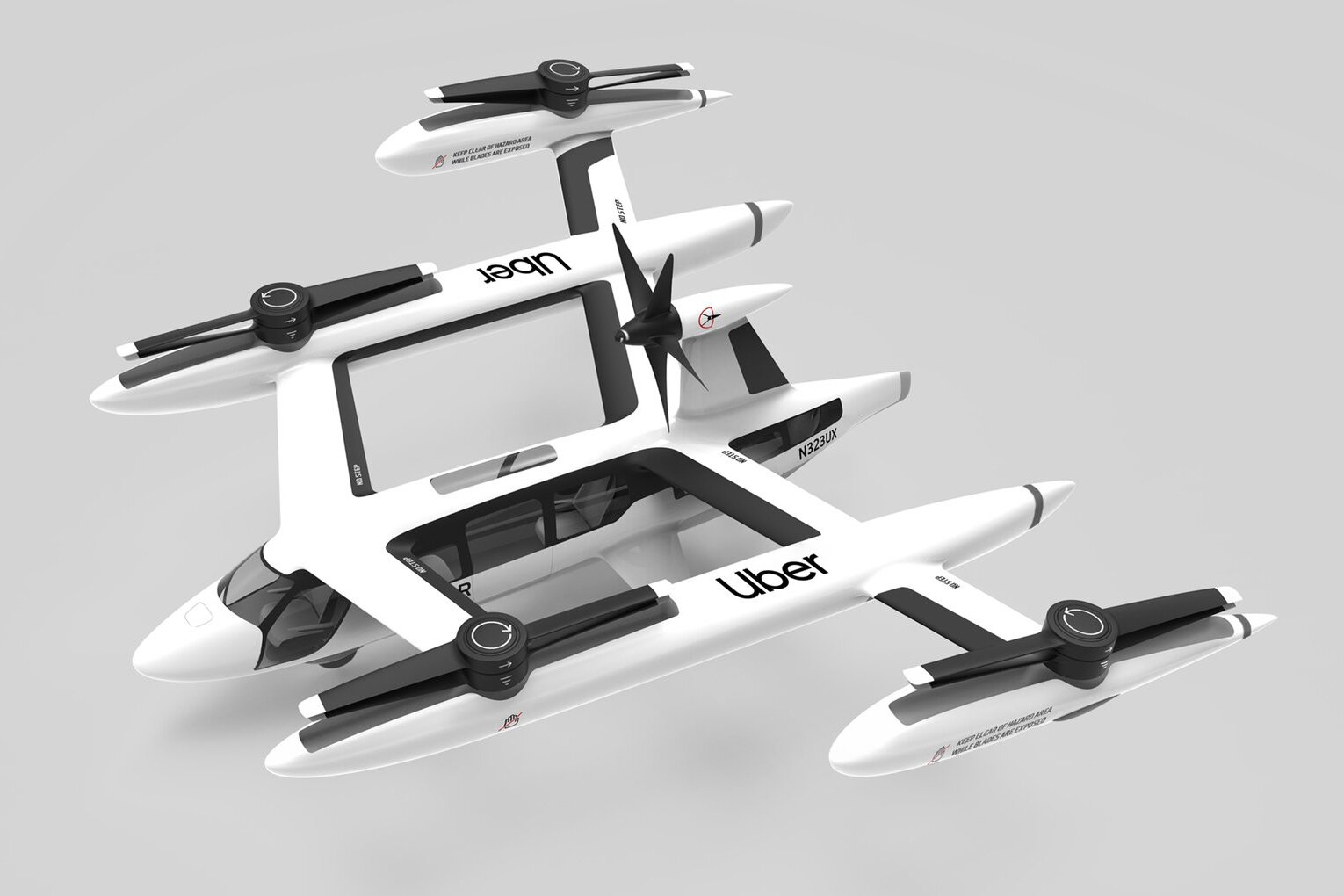I.
Flyers to Your Corners
For a while now, the eVTOL space has been kind of degenerate - lots and lots of obviously non-viable designs that nevertheless show up on your news feed because either:
Some big, legacy mobility company is trying to convince investors they're not about to be disrupted out of existence
Some founders/early investors are trying to make noise to attract more investors into what's definitely not a Ponzi scheme
It's a slow news day for evtol.news who are just happy that anyone besides helicopter nerds care about vertical flight
All this combines to ensure that the #eVTOL hashtag on Twitter is mostly an r/wallstreetbets-style flock of day traders with their heads on a swivel looking for the right SPAC stock ticker to buy and “hodl” until it goes to the moon.
Beneath (or above) all this noise, there were previously three "real" eVTOL companies/efforts worth paying attention to - Joby Aviation, Kitty Hawk, and Project Vahana. Joby has the most straightforward story - a startup founded by some engineers who were ahead of the game on the idea of using distributed electric propulsion to create light aircraft capable of both vertical take-off and extended range. Kitty Hawk was the pet-project of Larry Page which screwed around with lots of weird toys until they bought out Zee.Aero and got serious about making an air-taxi vehicle. Project Vahana was inside Airbus's experimental incubator/R&D-house, A${}^3$, until the grounding of the Boeing 737 MAX meant that Airbus suddenly needed every dollar it had to pump into marketing the A320neo to try and steal customers away from Boeing.



Images: Joby Aviation, Wisk Aero, Airbus A-cubed
The Project Vahana team appeared to be scattered to the wind until early last year when its chief engineer popped up at Archer Aviation - a newly formed team but with a surprisingly mature design. With Vahana kaput and only ever having showcased a testbed aircraft, it seemed like Archer was picking up from where they left off, carrying what the team had learned forward toward a certifiable, mission ready aircraft.
That might already seem like it should raise some eyebrows about technology and IP transfer, but keep in mind that the last few years have been ferociously active with eVTOL R&D in both academic and industrial settings. Specific data and design points might remain trade secrets in industry, but general ideas have been poked and prodded out in the open - their pros-and-cons debated, tested, and reported on in conference and journal papers, blogs, and classrooms. The idea of a design team being able to lift-and-shift to a new company and come up with a design from first principles or published studies in short order isn't unreasonable.
Which brings us roughly to the present. In 2019, Kitty Hawk partnered with Boeing and re-organized their efforts into a joint venture now called Wisk, but that didn't much affect the state-of-play. We've still got basically three eVTOL companies worth paying attention to, and two of them have now gotten into a spat.
II.
Two Aerospace Engineers Walk Into a Bar Exam
Wisk is alleging that Archer stole trade secrets (by having Wisk engineers copy them and then bring them over to Archer for a fat bump in compensation) and that their design is a wholesale copy of a previously undisclosed vehicle that Wisk filed a patent application for last year. The "money shot" comparing Wisk's patent application to Archer's investor deck seems pretty damning, but lets not get ahead of ourselves.
Image: Wisk Aero (and, presumably, Archer Aviation)
Patents have to meet four key criteria in order to be valid - the Subject Matter requirement, The Utility requirement, the Novelty requirement, and the Non-Obviousness requirement. The Subject Matter and Utility requirements are usually trivial to meet - they just require that the invention-to-be-patented is the sort of thing which should be patented (as opposed to subject to copyright, a trademark, or other IP protection) and that the invention actually does something useful. Utility might seem tricky to validate in some cases, but since patenting something useless doesn't really hurt anyone, the USPTO doesn't do extensive checking on this requirement.
The Novelty and Non-Obviousness requirements are where we really get to the meat of things. Novelty requires that the invention be, well, novel - not previously disclosed or showcased by a patent, public demonstration, or other prior art. If the USPTO (or, more commonly, someone being sued for violating a patent after it's been granted) discovers that your invention was put out in public prior to your filing for a patent, the patent can be denied or revoked after the fact. Wisk is pretty obviously in the clear in this one - there’s likely to be some haggling back and forth about how broad their patent can be, but they’ll find a set of claims to go into the patent that at least makes the USPTO happy (and hopefully themselves as well).
The last hang-up, the Non-Obviousness requirement, is also the most interesting. It requires that your invention not be an obvious combination of previously established inventions. You can't patent a "shaded lamp" if both a lamp and a lampshade have already been patented, even though a "shaded lamp" has not itself been explicitly patented. How obvious is obvious? The standard is "...that the subject matter as a whole would have been obvious at the time the invention was made to a person having ordinary skill in the art to which said subject matter pertains." (35 U.S.C. 103a)
Who in the hell has "ordinary skill" in the art of designing a new class of passenger aircraft without much precedent and precisely zero as-yet certified, available-to-purchase models? Probably no one who doesn't have at least a mild interest in the outcome of this case, but really the question is what a patent examiner or judge's impression of what ordinary skill looks like. Wisk will want their patent examiners to think that ordinary skill refers to as low a bar as possible - like a freshly graduated aerospace engineer with no particular familiarity with eVTOL design. Archer (and everyone else) will want that bar to be as high as possible - an expert who's been following eVTOL design for years and knows everything public about it, lacking only any particular company's proprietary data for making design decisions.
If Wisk gets their way, their patent is likely to stick. Their vehicle looks like nothing in any aircraft design textbook and combines lots of new ideas developed precisely for eVTOL design. If Archer gets their way, they at least have a chance of invalidating Wisk's patent, or preventing it from being granted in the first place. While there's no other aircraft that's exactly like Wisk's, nothing about it appears to be mind-blowingly original. Their blog post about it mentions the number and arrangement of rotors on the Archer vehicle as something that's too close to Wisk's approach to have been arrived at independently, but from a patent perspective, what matters is whether that approach is an obvious combination of prior art.
The trick of stopping the rear rotors and locking them in place to minimize drag is something of Wisk's signature, but the idea itself dates back to the Zee.Aero days and has since appeared in one of Uber Elevate's CRMs (which appears in Wisk's own blog post!) and Vertical Aerospace's VA-X4. In fact, the VA-X4 has both the stopped rotors and the V-tail, the other distinctive feature that Wisk calls out in their post.



Images: Uber Elevate, Vertical Aerospace, Joby Aviation
Wisk calls the V-tail "unconventional", but V-tails have been in use in aviation since 1930 and in eVTOLs specifically since at least the Joby S2 in 2014. To be honest, if the combination of front tiltrotors, locking rears, and a V-tail are the basis for Wisk's patent application, I think it's got a real challenge to get over the Non-Obviousness requirement, assuming "ordinary skill" is interpreted to mean somewhere around the level of an aircraft configuration designer. All of those elements are pre-existing to some degree or another, and the fact that Joby had two of them for years beforehand and the VA-X4 has all three with no alleged IP theft undercuts Wisk's argument. The VA-X4 isn't a slam dunk counter-point only because it's new enough that Wisk may have filed their patent application before its debut.
Wisk likely has, or has filed for, more narrow patents on specific parts of their aircraft, but the Archer vehicle is different enough that is subsystems are unlikely to infringe on those. The rotor blades themselves are completely different, and the overall profile of the fuselage, wing and V-tail is different enough to have required an independent optimization process rather than actually being a wholesale copy of the Wisk vehicle. (Plus the Wisk vehicle has skids for landing gear as opposed to Archer's tricycle gear.)
III.
Energy-Maneuverability Theory
All this suggests that Archer was likely "looking over Wisk's shoulder". They probably came into possession of Wisk's IP via poached employees if the results of Wisk's internal investigation can be taken at face value, but it doesn't quite get over the line from my perspective. What Wisk has disclosed isn't enough to conclude that the Archer vehicle itself is a copy of Wisk's vehicle, even from an engineering standpoint, much less a legal one. Archer may have looked at Wisk's homework, but they only "copied" the stuff that's out there in public anyway, and the actual details are different enough to indicate that the Archer vehicle is original, if generic.
All of that is subject to change as new details come out, but considering that most of what we know is Wisk's version of events and that even so it's not conclusive, Archer has a good chance of beating the case. Wisk may be counting on a smoking gun emerging in discovery, but that's a pretty risky bet to take, suggesting that Wisk is likely filing suit for reasons other than an expectation that they'll be able to win a decisive victory.
Just filiing the suit does some reputational damage to Archer, perhaps undercutting investor, partner and customer confidence just as they're preparing to go public through a SPAC and seal a $1B order from United Airlines. They may simply be looking to tie up and distract senior management just as the company turns the corner into a viable, ongoing concern. They may also be firing an internal warning shot at any other engineers looking to jump ship out of Wisk - putting them on notice that any moves to rival firms will put them under a microscope.
It's worth noting that filing this lawsuit isn't costless or riskless for Wisk. They could end up with a decisive ruling against them, invalidating their patents or other IP protection, and as much as it might undermine confidence in Archer's integrity it also undermines confidence in Wisk's ability to protect its IP without resorting to lawsuits. Whatever effect it might have on employee retention, it's also likely to have an effect on employee morale. If they have a genuine and ongoing brain-drain problem this might stem the tide, but anyone who was looking to jump ship might resent the extra scrutiny and simply be smarter about how they sweeten the deals for their new employers. (I mean, really? A midnight copy-and-paste job immediately before you jump ship? C'mon.)
Either way, it reflects that the stakes in the eVTOL game have raised significantly in the past year or so. The overall winner in this particular hand is likely neither Wisk nor Archer, but Joby Aviation. Their own recent SPAC deal puts their valuation nearly double Archer's (\$6.6B vs \$3.8B) and they can now sit back and watch their two biggest rivals duke it out in the courts for the next few years.






